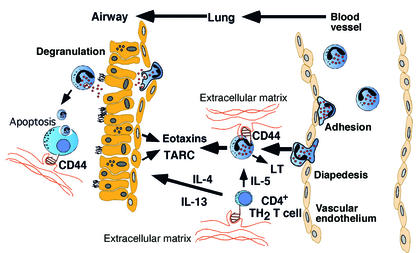Figure 1.
Overview of immunological mechanisms in the development of allergic eosinophilic airway inflammation involving CD44. There are multiple mechanisms by which CD44 may effect the propagation and resolution of allergic airway inflammation. Engagement of CD44 by a variety of ligands (typically extracellular matrix components such as HA) on CD4+ T cells and eosinophils promotes cellular chemotaxis, activation, and survival. Th2 cell-derived IL-4 and IL-13 potently induce critical chemokines (including TARC and the eotaxins) by several resident cells in the lung (e.g., respiratory epithelium), and induce direct asthma responses (including mucus production and airway hyperreactivity). Eosinophils further exacerbate allergic inflammation by production of potent smooth muscle constrictors (e.g., LTs) and by the cytotoxic effects of their granule proteins on lung cells. CD44 may also have an important role in resolution of allergic airway inflammation by promoting the removal of apoptotic airway cells by macrophage-mediated CD44-dependent phagocytosis and clearance.

